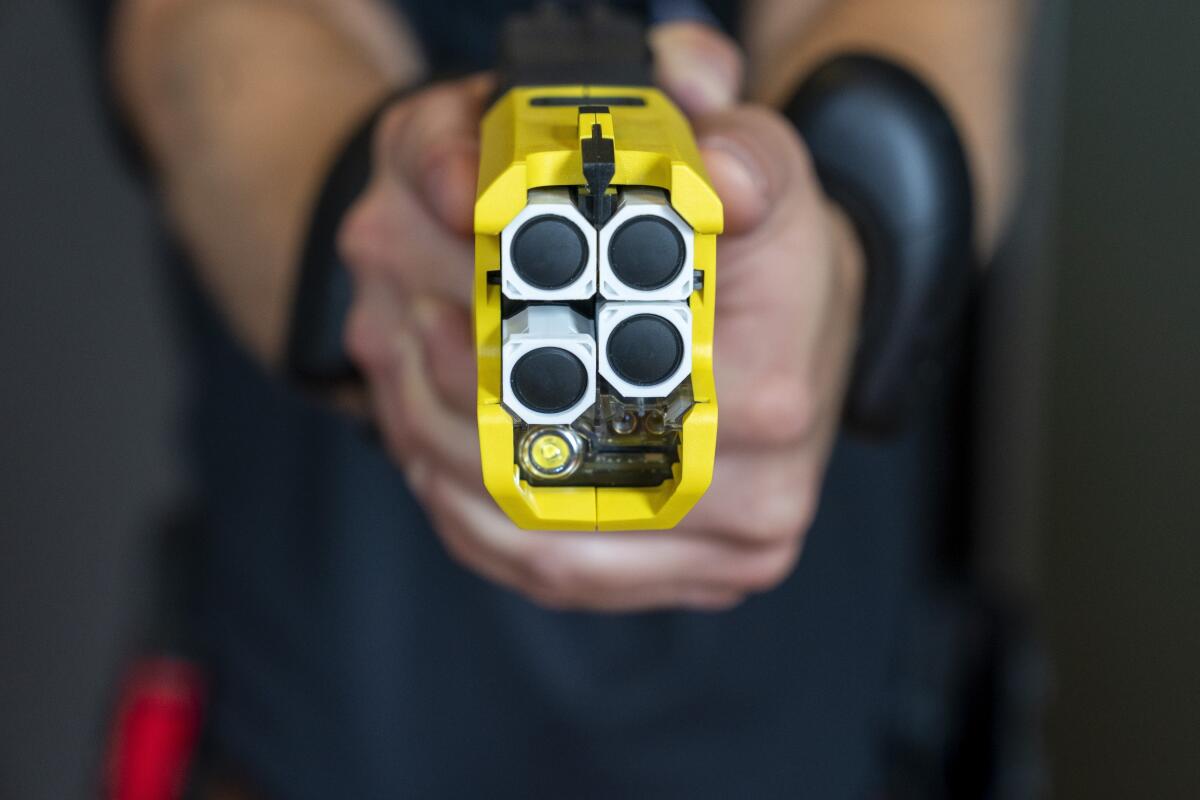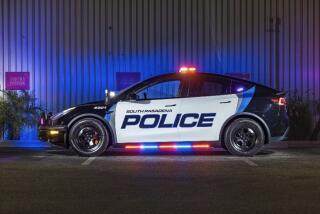LAPD officers to test next-gen Taser with 45-foot range

The Los Angeles Police Department will test a new generation of Tasers that have greater range, which LAPD officials say could help officers more easily control uncooperative people and prevent the use of deadly force.
The Police Commission unanimously approved a yearlong pilot program to test the new Taser 10 devices at its meeting Tuesday morning.
During a presentation, LAPD Deputy Chief Marc Reina told the oversight body that the new model is an improvement over its predecessor, the Taser 7, in several key ways. The older Taser shoots two barbed darts on a wire up to 22 feet long, delivering a powerful electric shock that disables a person for about five seconds by âjammingâ their central nervous system. The newer models deliver a similar voltage but have a range of 45 feet and 10 metallic prongs instead of two, which can be fired individually to give officers better control and accuracy, Reina said.
Initially, he said, the devices will be rolled out at the four divisions with the highest rates of Taser use: Southeast, 77th Street, Central and Hollywood. Each division will receive about 200 Taser 10s, and the officers who are assigned the devices will receive two hours of additional training.
Reina said the department hoped to gather data over the coming months to help determine whether to switch permanently to the Taser 10s.
Critics have long argued that Tasers are unreliable â the departmentâs own statistics show that they are successful only half the time â and that calling the devices âless lethalâ is a misnomer, because they sometimes do cause death.
The pilot program comes on the heels of changes in the departmentâs Taser policy, including barring officers from using the so-called drive stun function, in which the device is pressed directly against someoneâs skin rather than fired from a distance. Department officials said such âpain complianceâ measures have been found to be counterproductive in some cases, especially with people who suffer from certain underlying health issues that can be aggravated by the electric shocks.
Under the previous policy, officers who encountered a person armed with a knife couldnât use an âintermediate force optionâ such as a Taser if the person was simply refusing to drop the knife. If the situation escalated, the officers were trained to resort to deadly force â an outcome that they might have avoided if they were allowed to use Tasers earlier in the encounter, officials said.
After Keenan Anderson died after an encounter with LAPD officers in which he was tased repeatedly, relatives filed a $50-million wrongful-death claim.
âWhat weâre trying to do is create options for our officers where theyâre able to use [less-lethal force] before they have to resort to deadly force,â Assistant Chief Dominic Choi told commissioners.
The LAPD has long used the Taser, a brand of stun gun produced by Axon Enterprise, which also manufactures body-worn and dashboard cameras.
According to advertising on Axonâs website, the Taser 10 has increased accuracy, which âcreates time and space to de-escalate and resolve conflicts.â
The 800 devices would cost the department about $3 million, LAPD Chief Michel Moore said, a price tag that also covers certain add-ons, including upgraded dashboard cameras from Axon.
In 2022, LAPD officers used Tasers 361 times, an 18% decrease from the year before, according to the departmentâs annual use-of-force report.
Moore on Tuesday compared the now-banned drive stun mode to pressing a spark plug against someoneâs exposed skin. âItâs not going to incapacitate the muscle, but it is going to have a tremendous amount of pain,â he said. The latest version of the Taser no longer features the stun mode.
The change comes in the wake of several recent high-profile police encounters involving Tasers. In one notable case, Keenan Anderson, a 31-year-old teacher and father, died this year after being shocked multiple times during a traffic stop. Andersonâs death drew widespread condemnation, including from Mayor Karen Bass, and fueled renewed calls to remove armed police from traffic duty.
The L.A. County coronerâs report cited an enlarged heart and cocaine use as the causes of Andersonâs death and did not rule it a homicide. His manner of death remains undetermined, according to the coronerâs website. But Andersonâs family disputed the reportâs findings, saying it deflected blame from the police. A lawsuit against the city by the family is pending.
Even before Andersonâs death, the city had paid civil settlements as a result of incidents involving Taser use.
In 2020, the city approved a $5.75-million settlement with the parents of a 39-year-old Marine veteran who died after an LAPD officer stunned him six times with a Taser during a 2014 Christmas Eve altercation. As with Anderson, a coronerâs report said that he died because of an enlarged heart and that cocaine intoxication and police restraint by a Taser were contributing factors.
Staff writer Richard Winton contributed to this report.
More to Read
Sign up for Essential California
The most important California stories and recommendations in your inbox every morning.
You may occasionally receive promotional content from the Los Angeles Times.












